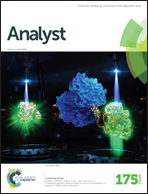Streptavidin-triggered signal amplified fluorescence polarization for analysis of DNA–protein interactions†
Abstract
Fluorescence polarization (FP) is a sensitive, robust, and homogeneous assay format, able to probe a diversity of biological molecules and their interactions. Herein, we describe a new FP strategy based on the use of streptavidin as a signal amplifier. Such signal amplified fluorescence polarization (SAFP) was used to monitor the binding affinity of human angiogenin and a single-stranded DNA aptamer. Streptavidin was bound to a biotinylated single-stranded DNA aptamer and the interaction between this complex and Alexa Fluor 488 labelled human angiogenin was measured. A dissociation constant of 135.3 ± 32.9 nM and a limit of detection of 6.3 nM were successfully extracted only when the FP signal was increased (without binding hindrance) via streptavidin. Moreover, the demonstrated approach was specific to target molecules without any non-specific binding. The streptavidin-triggered SAFP method unlike amplification strategies that utilize nanomaterials (such as graphene oxides, carbon nanotubes, and metal nanoparticles) is not compromised by fluorescence quenching, and it is able to operate within nanomolar concentration regimes. Furthermore, unlike the other FP signal amplification strategies that use dual binding DNA probes, the presented method is simple to implement with signal amplification only requiring the binding of streptavidin with biotinylated DNA. This method could be expanded to analyze molecular interactions and it may be a useful tool for FP measurement by reducing the concentration of rare and expensive protein samples.


 Please wait while we load your content...
Please wait while we load your content...